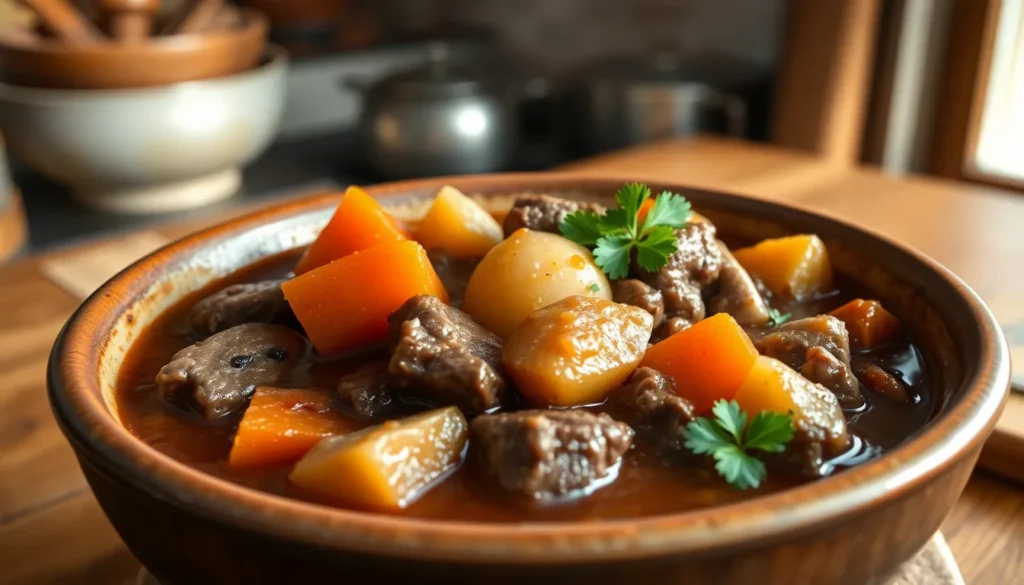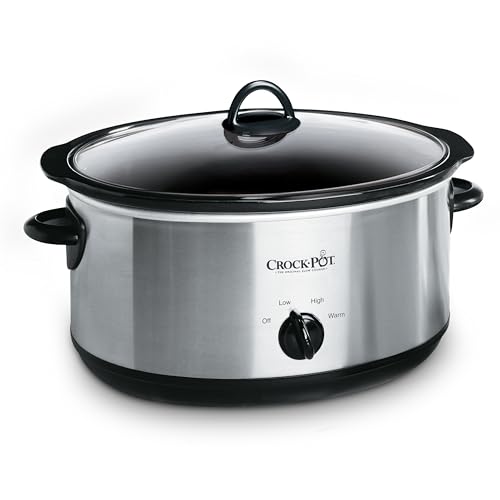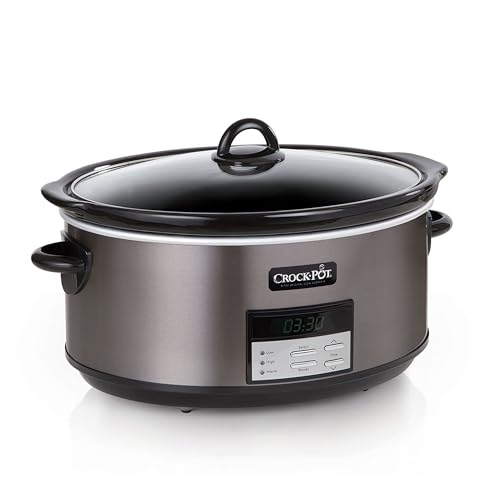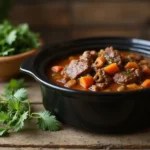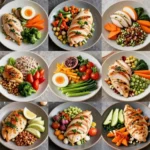When winter winds start howling and we’re craving something soul-warming, nothing beats Martha Stewart’s legendary beef stew recipe. This isn’t just any ordinary stew – it’s a masterclass in comfort food that transforms simple ingredients into pure culinary magic. Martha’s approach elevates this classic dish with her signature attention to detail and foolproof techniques.
We’ve tested countless beef stew recipes over the years, but Martha’s version consistently delivers the perfect balance of tender meat, rich gravy, and perfectly cooked vegetables. Her secret lies in the careful layering of flavors and the patience to let each step work its magic.
What makes this recipe truly special is how it manages to be both elegant enough for dinner parties and comforting enough for weeknight family meals. Whether you’re a seasoned cook or just starting your culinary journey, Martha’s beef stew will become your go-to recipe for creating unforgettable meals that bring everyone to the table.
Ingredients
We’ve carefully selected each ingredient to ensure Martha Stewart’s signature depth of flavor and perfect texture. These quality components work together to create the rich and satisfying stew that has made this recipe legendary.
For the Beef Stew
- 3 pounds beef chuck roast, cut into 2-inch cubes
- 3 tablespoons all-purpose flour
- 2 teaspoons kosher salt
- 1 teaspoon freshly ground black pepper
- 3 tablespoons olive oil
- 2 large yellow onions, cut into 1-inch pieces
- 3 medium carrots, peeled and cut into 1-inch pieces
- 3 celery stalks, cut into 1-inch pieces
- 3 tablespoons tomato paste
- 1/2 cup dry red wine
- 4 cups beef stock
- 1 pound small red potatoes, halved
- 8 ounces cremini mushrooms, quartered
- 2 tablespoons fresh parsley, chopped
For the Herb Bundle
- 3 fresh thyme sprigs
- 2 fresh rosemary sprigs
- 2 bay leaves
- Kitchen twine for bundling
Optional Garnishes
- 2 tablespoons fresh parsley, finely chopped
- 1 tablespoon fresh thyme leaves
- Crusty bread for serving
- Sour cream or crème fraîche
Equipment Needed
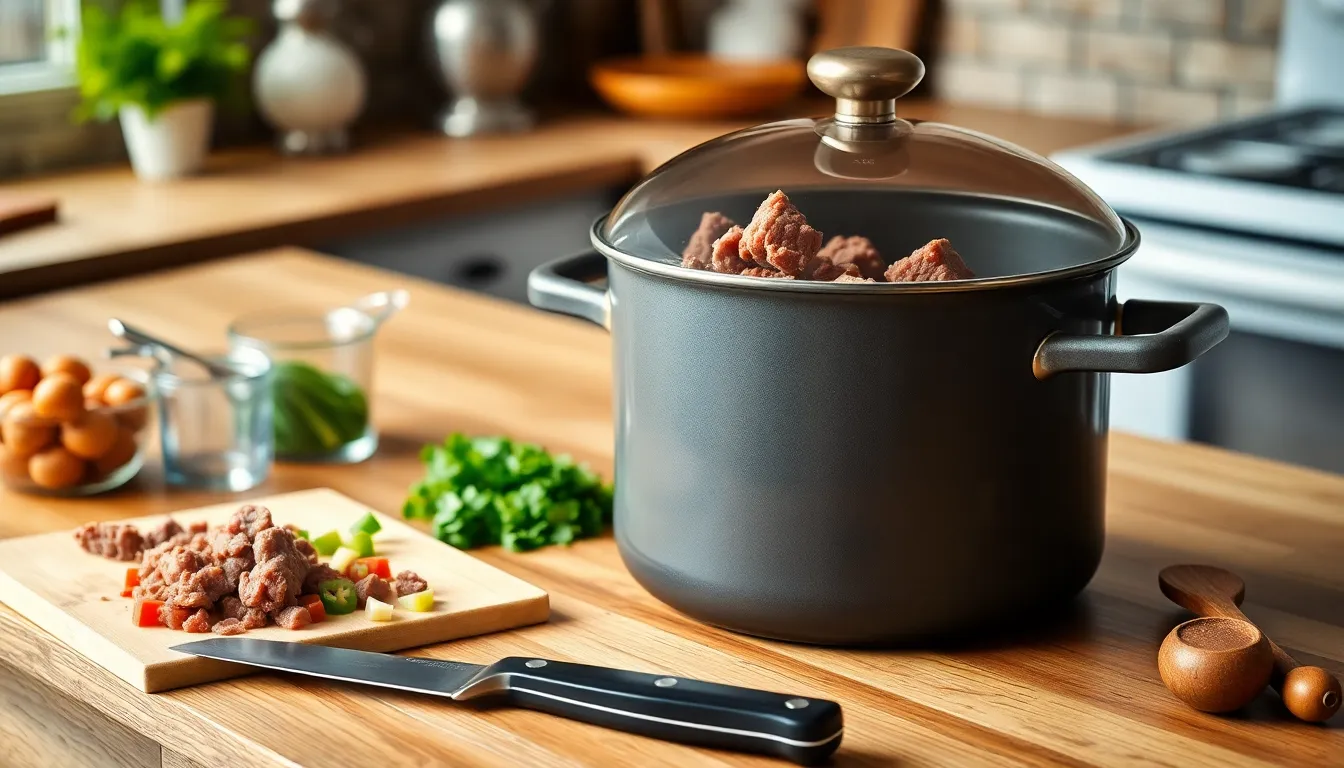
We recommend gathering these essential tools before beginning Martha Stewart’s beef stew recipe to ensure smooth preparation and cooking:
5-quart Dutch oven serves as the cornerstone piece for this recipe. This heavy-bottomed pot allows us to bring the stew mixture to a boil on the stovetop before transferring it to the oven for the long braising process. An oven-safe heavy pot with a tight-fitting lid works as an alternative if you don’t own a Dutch oven.
Sharp knife and cutting board are necessary for preparing the beef chuck into 1½-inch cubes and chopping all vegetables to uniform sizes. Consistent cuts ensure even cooking throughout the 2 to 2½ hour cooking time.
Measuring cups and spoons help us achieve the precise ingredient ratios that make Martha’s recipe consistently successful. Accurate measurements are particularly important for the flour coating and balsamic vinegar that build flavor without traditional searing.
Mixing spoon or spatula allows us to thoroughly combine the beef cubes with flour and vegetables before cooking begins. This tool also helps us stir the mixture as we bring it to a boil.
Preheated oven set to 350°F creates the ideal braising environment for tender, fork-ready beef. The steady oven heat transforms tough chuck roast into melt-in-your-mouth perfection over the extended cooking period.
Having these tools ready streamlines the 15-minute prep time and sets us up for success with this classic comfort food recipe that yields 6 generous servings.
Prep Work
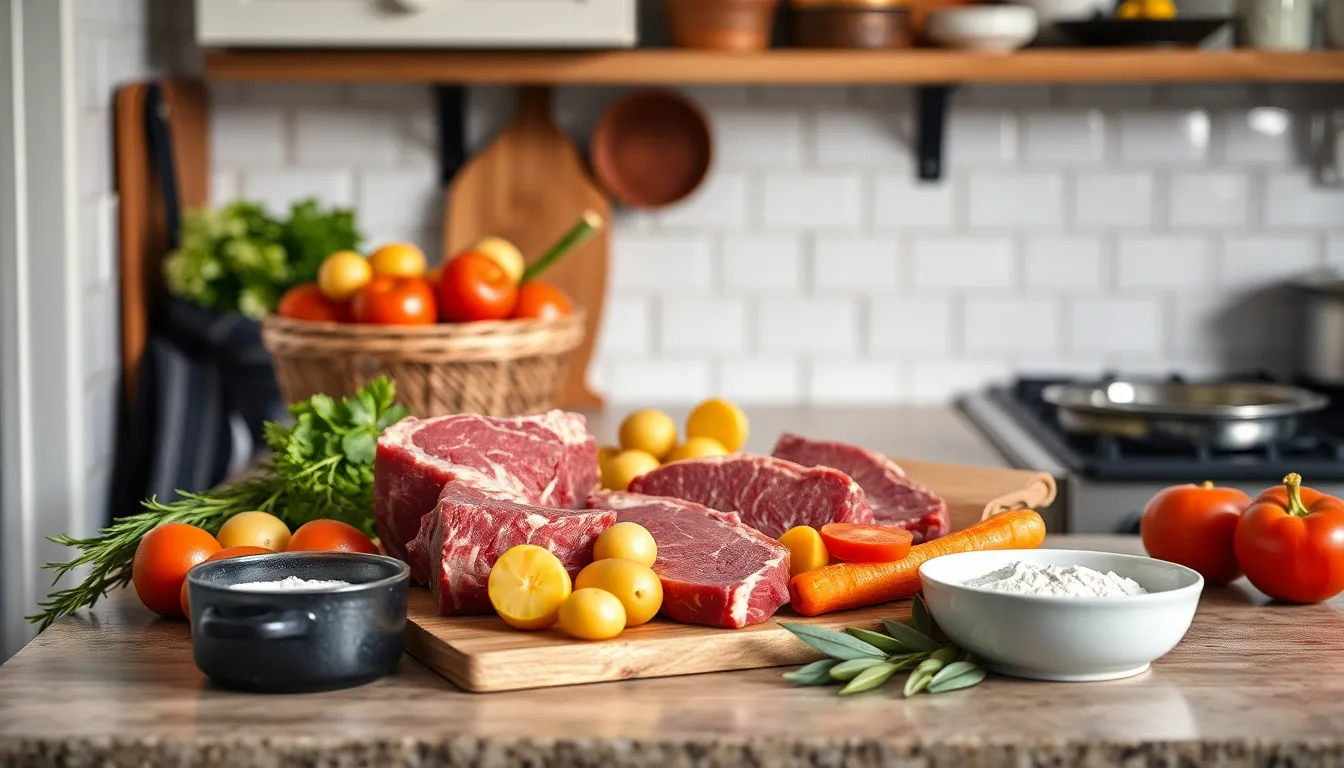
Proper preparation sets the foundation for Martha Stewart’s exceptional beef stew. We’ll break down each component to ensure perfectly balanced flavors and textures.
Preparing the Beef
We start with 2 pounds of beef chuck, preferably grass-fed, cut into uniform 2-inch chunks. The key lies in lightly coating each piece with unbleached all-purpose flour or a gluten-free flour blend for those avoiding gluten. This flour coating serves dual purposes: it helps thicken our stew naturally while adding deeper flavor during the browning process.
Season the floured beef generously with kosher salt and freshly ground black pepper. We want every piece well-seasoned before it hits the pan. The seasoning penetrates the meat during cooking and creates the flavor foundation our stew needs.
Chopping Vegetables
Our vegetable preparation focuses on creating uniform pieces that cook evenly. We peel and cut about 1 pound of potatoes into large chunks, ensuring they match our beef pieces in size. The 1/2 pound of carrots gets peeled and cut into similar-sized chunks for consistent cooking times.
Next, we chop our onions into medium pieces and mince 2 cloves of garlic. These aromatics build the flavor base that makes Martha’s recipe so distinctive. The onions provide sweetness while the garlic adds depth that permeates throughout the entire stew.
Making the Herb Bundle
Bay leaves form the cornerstone of our herb profile in this classic recipe. We typically use 2-3 bay leaves to infuse the stew with their subtle but essential aroma during the long simmering process. Martha’s approach keeps the herb selection simple yet impactful.
Some variations include fresh thyme or rosemary, but the traditional recipe relies on bay leaves as the primary herb component. These leaves release their oils slowly during cooking, creating the distinctive flavor that makes this stew memorable.
Instructions
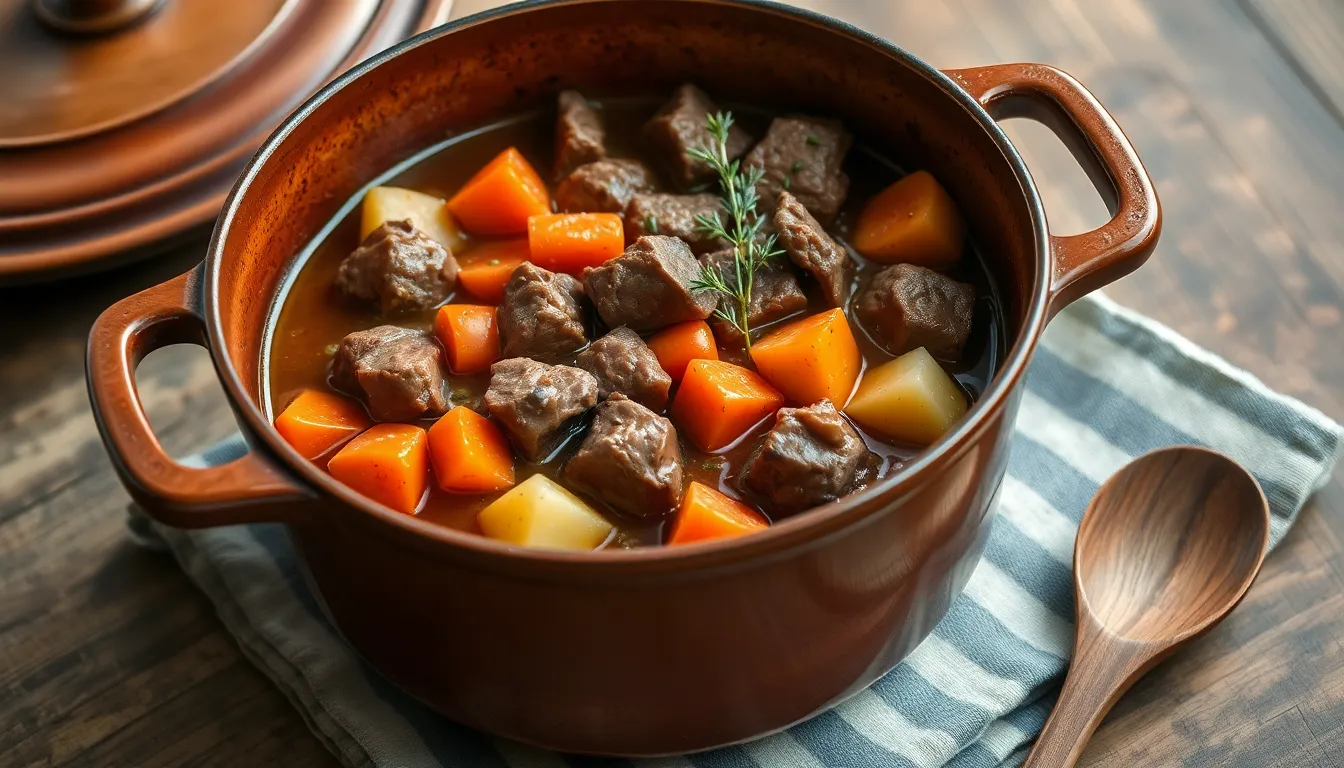
We follow Martha Stewart’s proven six-stage method to create this exceptional beef stew. Each step builds upon the previous one to develop layers of complex flavor and achieve perfect tenderness.
Browning the Beef
We heat 2 tablespoons of olive oil in our Dutch oven over medium-high heat until it shimmers. The flour-dusted beef chunks go into the hot oil in a single layer without overcrowding the pan. Each piece needs to brown for 3-4 minutes per side until we achieve a deep golden crust on all surfaces. This caramelization process seals in the juices and creates the foundation for rich flavor. We transfer the browned beef to a plate and set aside while we continue with the next step.
Building the Base
We add another tablespoon of oil to the same Dutch oven and reduce heat to medium. The diced onions go in first and cook for 5-6 minutes until they become translucent and softened. We stir in the tomato paste and cook for 1 minute until it darkens slightly and becomes fragrant. Next we add the Worcestershire sauce and red wine while scraping up any browned bits from the bottom of the pot. This aromatic base provides depth and complexity that distinguishes Martha’s recipe from ordinary beef stews.
Adding Liquids and Seasonings
We pour in 4 cups of beef broth and bring the mixture to a gentle simmer. The minced garlic and herb bundle containing bay leaves and thyme get added at this stage. Some recipes benefit from a splash of balsamic vinegar to brighten the overall flavor profile. We return the browned beef to the pot along with any accumulated juices. The liquid should just cover the meat pieces for proper braising.
Simmering the Stew
We cover the Dutch oven with its lid and transfer it to our preheated 350°F oven. The slow braising process takes 2 to 2.5 hours and transforms tough chuck roast into fork-tender perfection. This oven method provides even heat distribution that you cannot achieve on the stovetop. We check occasionally to ensure the liquid maintains a gentle simmer rather than a rapid boil.
Adding Root Vegetables
After the beef has simmered for about 1.5 hours we add the prepared root vegetables. The potato chunks and carrot pieces go into the pot and get stirred gently to distribute them evenly. These vegetables need approximately 45 minutes to 1 hour to become tender while absorbing the rich flavors of the stew. The starch from the potatoes naturally thickens the broth during this final cooking phase.
Final Cooking Stage
We return the uncovered pot to the oven for the remaining cooking time until both vegetables and beef reach perfect tenderness. A fork should easily pierce the largest beef chunks and vegetables without resistance. We remove the herb bundle and bay leaves before serving. Final seasoning adjustments with salt and black pepper ensure the stew achieves its optimal savory balance that makes Martha Stewart’s recipe so memorable.
Cooking Tips for Perfect Results
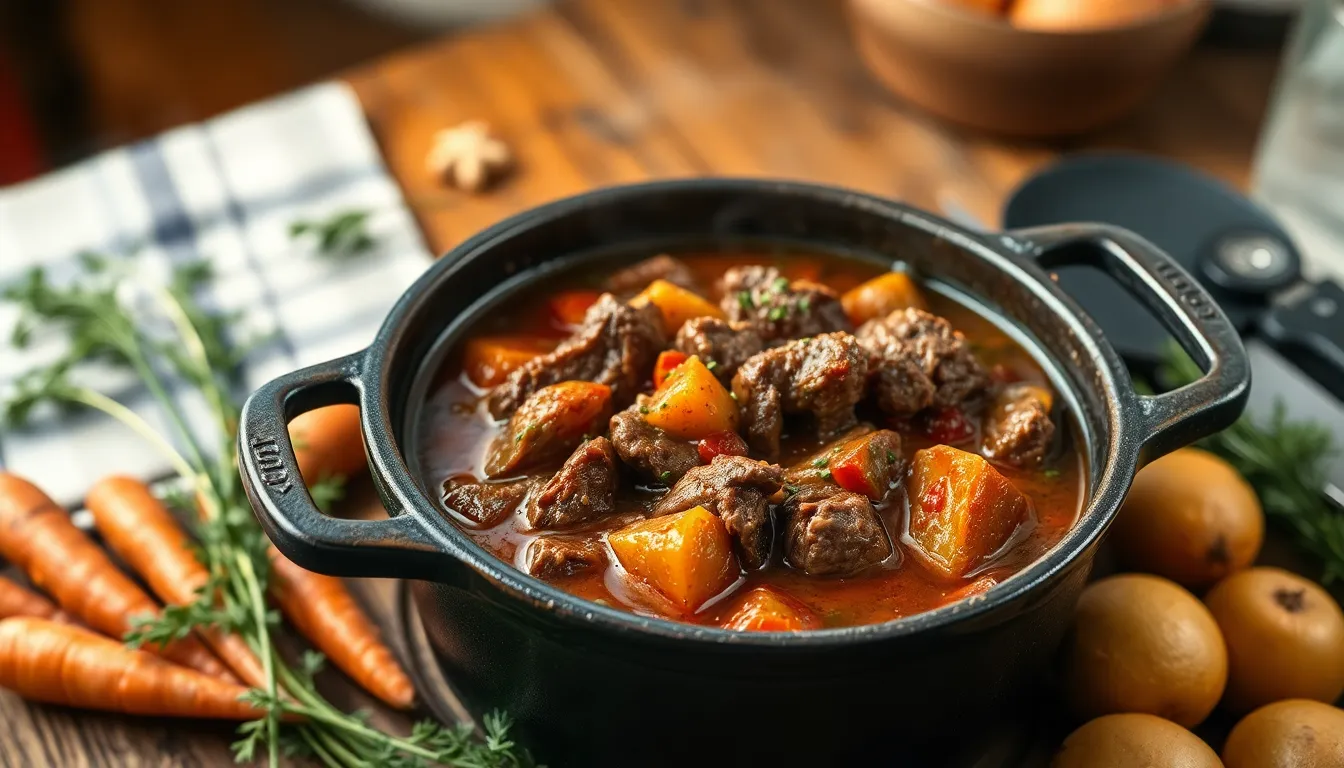
We’ve discovered that achieving Martha Stewart’s signature beef stew requires attention to several key techniques that transform ordinary ingredients into extraordinary comfort food. Our years of testing this recipe have revealed exact methods that consistently deliver restaurant-quality results at home.
Start with proper beef preparation by coating chunks with flour before browning. We combine all-purpose flour with tomato paste and a splash of vinegar to create a coating that enhances browning while building natural thickening power. This technique eliminates the need for additional thickeners later in the cooking process.
Minimize prep time without sacrificing flavor by organizing ingredients before cooking begins. Our streamlined approach requires only 15 minutes of active preparation time while delivering maximum taste impact through strategic ingredient layering.
Choose quality ingredients for noticeable flavor improvements. We recommend grass-fed beef chuck for superior taste and texture compared to conventional options. Fresh carrots and potatoes provide better results than frozen vegetables since they maintain their structure during the long cooking process.
Build depth through acid balance by incorporating vinegar and tomato paste early in the cooking sequence. We’ve found that this combination of acidic elements cuts through the richness of beef while creating complex flavor layers that develop throughout the cooking time.
Control liquid ratios by using beef broth instead of water for enhanced flavor concentration. When beef broth isn’t available we add extra salt to water and adjust seasoning at the end of cooking. This flexibility ensures consistent results regardless of pantry availability.
Monitor cooking time carefully during the slow simmering phase. We allow several hours for proper beef tenderness whether using stovetop or slow cooker methods. The slow cooker variation requires approximately 6 hours on low heat for optimal flavor melding with minimal hands-on attention.
Accommodate dietary restrictions by substituting gluten-free flour blend for all-purpose flour when needed. We’ve tested this modification extensively and found no compromise in thickening power or final texture when using quality gluten-free alternatives.
Season strategically throughout the cooking process rather than only at the beginning or end. We add kosher salt and freshly ground pepper during beef coating then adjust final seasoning after vegetables have absorbed the cooking liquids for balanced flavor distribution.
Make-Ahead Instructions
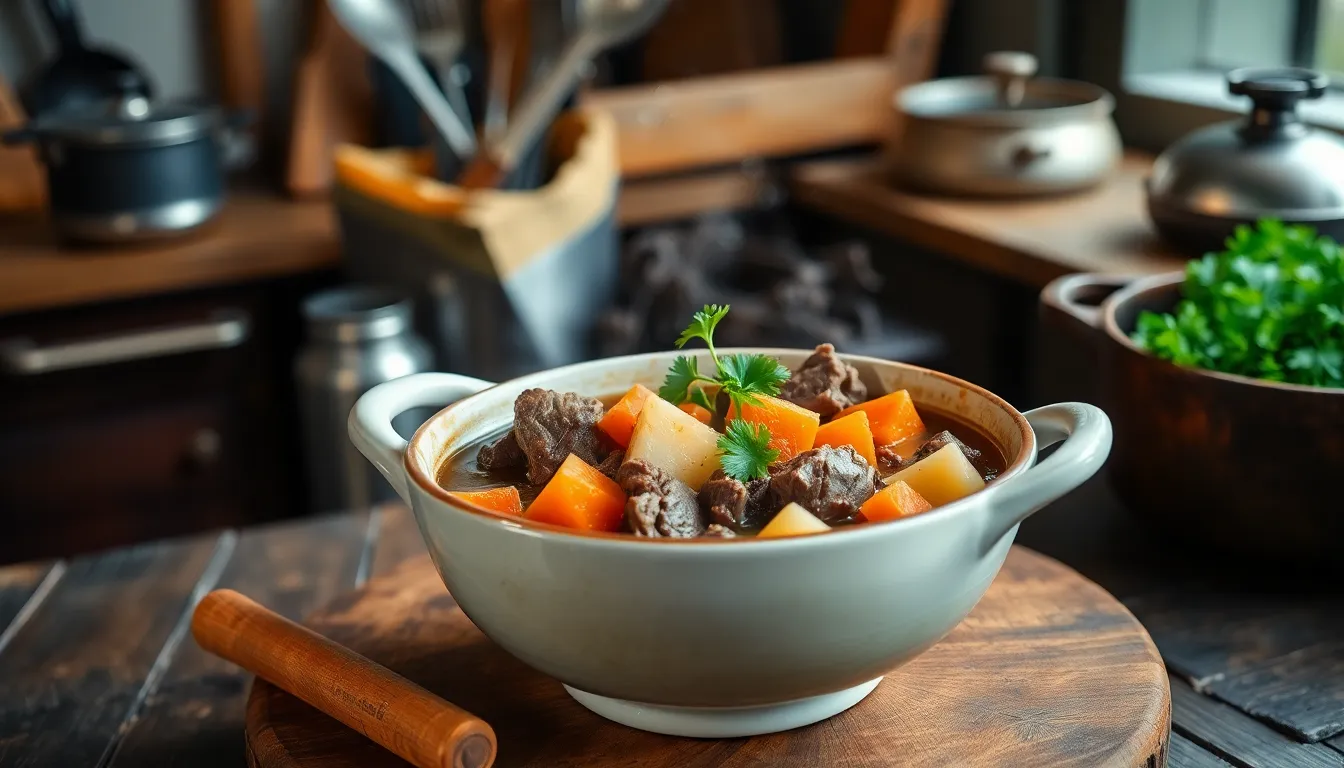
Martha Stewart’s beef stew transforms into an even more flavorful dish when prepared ahead of time. We recommend cooking the complete stew recipe and allowing it to cool completely before refrigerating for up to 3 days. The overnight resting period allows the rich flavors to deepen and meld together, creating a more complex taste profile that rivals any restaurant-quality dish.
Proper Storage Techniques
After cooking, we transfer the finished stew to shallow containers to promote rapid cooling. Large chunks of potatoes and carrots maintain their shape better during storage when cut into substantial 1-2 inch pieces initially. We store the cooled stew in airtight containers in the refrigerator, where it develops enhanced flavor depth over time.
Reheating Guidelines
Our preferred reheating method involves gentle warming on the stovetop over medium-low heat, stirring occasionally to prevent sticking. We add a splash of beef broth if the stew appears too thick after refrigeration. Slow cooker reheating works equally well on the warm setting for 1-2 hours, maintaining the tender texture of both beef and vegetables.
Optional Finishing Touches
Frozen peas create a beautiful color contrast and fresh sweetness when stirred into the reheated stew during the final 5 minutes of warming. We find this addition particularly appealing for visual presentation and nutritional balance. Fresh herbs like chopped parsley or thyme can be sprinkled on top just before serving to brighten the overall flavor profile.
Meal Planning Benefits
This make-ahead capability makes Martha’s beef stew perfect for busy weeknight dinners or entertaining guests. We often prepare double batches during weekend cooking sessions, freezing portions for future meals. The stew maintains its quality for up to 3 months in the freezer when properly stored in freezer-safe containers.
Storage and Reheating
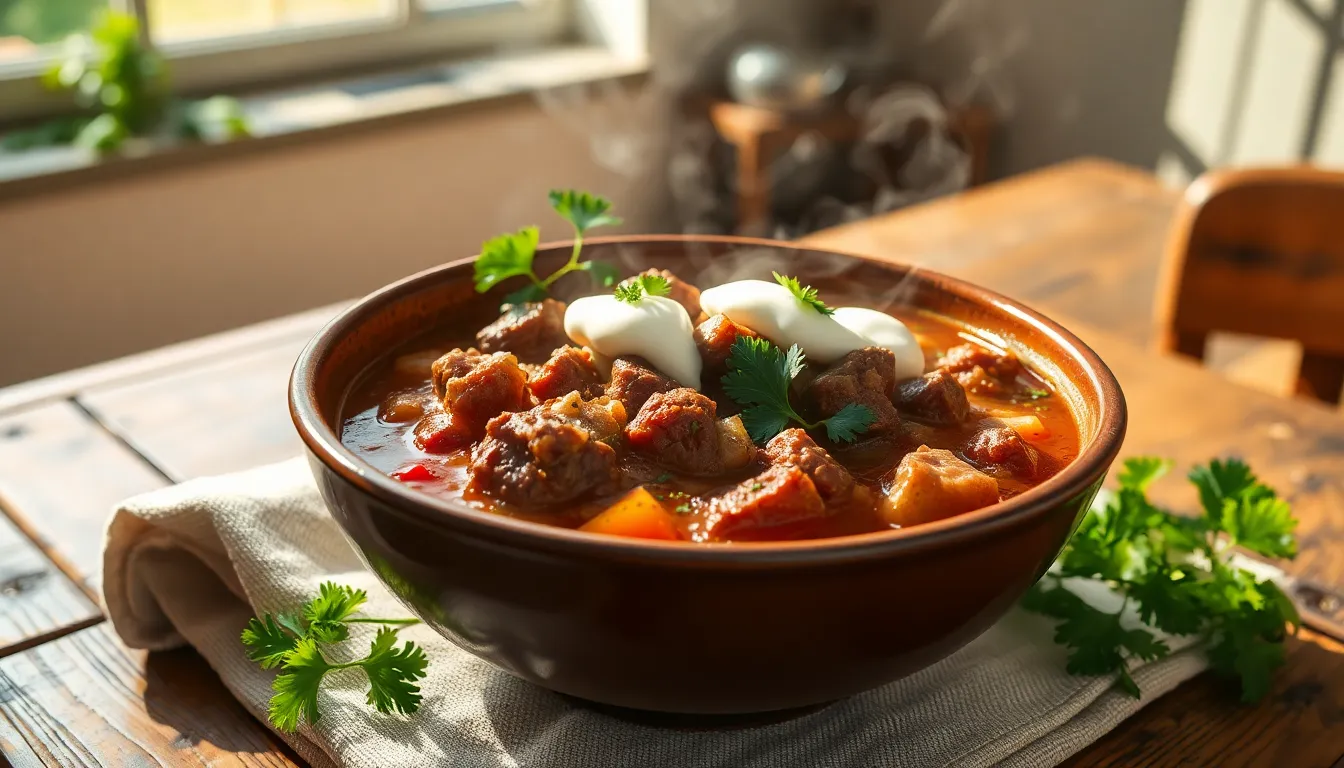
We always prioritize proper storage techniques to maintain our Martha Stewart beef stew’s exceptional quality and flavor profile. Complete cooling represents the first critical step before transferring our finished stew to storage containers. We recommend using airtight glass or plastic containers to preserve the stew’s rich texture and prevent unwanted odors from affecting the taste.
Our refrigerated beef stew maintains optimal quality for three to four days when stored correctly. We transfer the cooled stew to shallow containers for rapid cooling and place them directly in the refrigerator. Freezing extends storage life significantly with our stew remaining delicious for up to three months in airtight containers.
| Storage Method | Duration | Container Type |
|---|---|---|
| Refrigerated | 3-4 days | Airtight glass or plastic |
| Frozen | Up to 3 months | Airtight containers |
We reheat our stored beef stew using gentle methods to preserve its hearty texture and deep flavors. Our preferred technique involves using a covered saucepan over low to medium heat until the stew warms completely throughout. We stir occasionally during reheating to ensure even temperature distribution and prevent sticking.
Martha Stewart’s finishing touches elevate our reheated stew to restaurant quality standards. We prepare a fresh parsley and horseradish mixture as our signature topping before serving. Dollops of sour cream provide additional richness and visual appeal while improving the stew’s complex flavors.
We find that advance preparation actually improves our beef stew’s taste profile. The flavors meld beautifully during storage creating an even more satisfying dining experience. Our reheating process maintains the original texture while allowing us to add fresh garnishes that brighten each serving.
Serving Suggestions
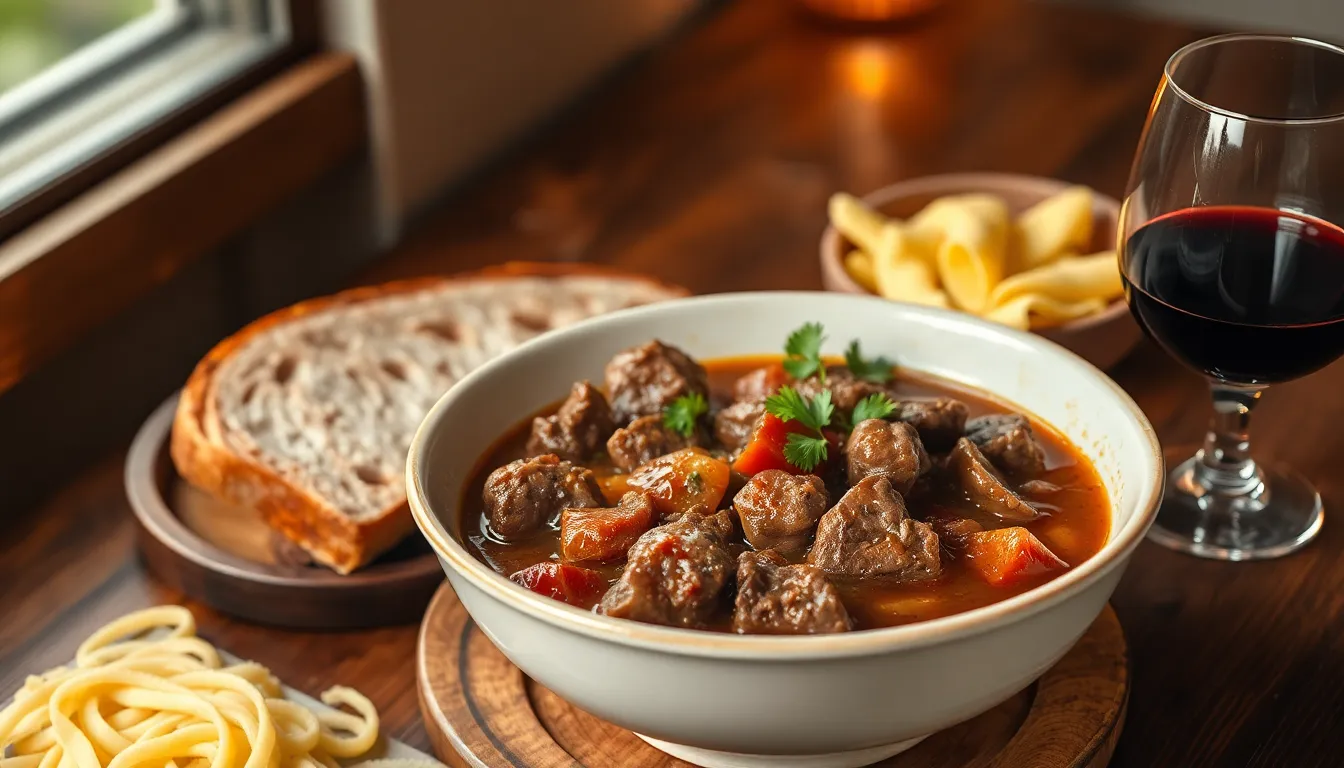
We recommend serving Martha Stewart’s beef stew hot in deep bowls to showcase the rich gravy and tender chunks of beef. Crusty bread makes an excellent accompaniment as it allows guests to soak up every drop of the flavorful broth. Buttered egg noodles provide another satisfying base that transforms the stew into an even more substantial meal.
Fresh herbs elevate the presentation and add brightness to each serving. We suggest garnishing with chopped fresh parsley to introduce color and a hint of freshness that balances the rich flavors. A small dollop of sour cream creates a luxurious contrast to the hearty beef and vegetables.
Pairing options enhance the overall dining experience without overwhelming the main dish. A simple green salad with light vinaigrette cuts through the richness of the stew while providing textural variety. Steamed green beans offer another vegetable side that complements the root vegetables already present in the dish.
For special occasions we recommend serving the stew family style in a large ceramic serving bowl placed at the center of the table. Individual ramekins filled with fresh herbs allow each diner to customize their portion. Warm dinner rolls or artisanal bread slices arranged on a wooden board create an inviting presentation.
Wine pairings work beautifully with this comforting meal. A medium bodied red wine such as Pinot Noir or Merlot enhances the beef flavors without competing with the dish. For those preferring non alcoholic options sparkling water with lemon provides a refreshing cleanse between bites.
Temperature considerations ensure optimal enjoyment of the stew. We serve it immediately after the final seasoning adjustments to maintain the perfect consistency. Individual bowls should be warmed beforehand to keep the stew at the ideal serving temperature throughout the meal.
Recipe Variations
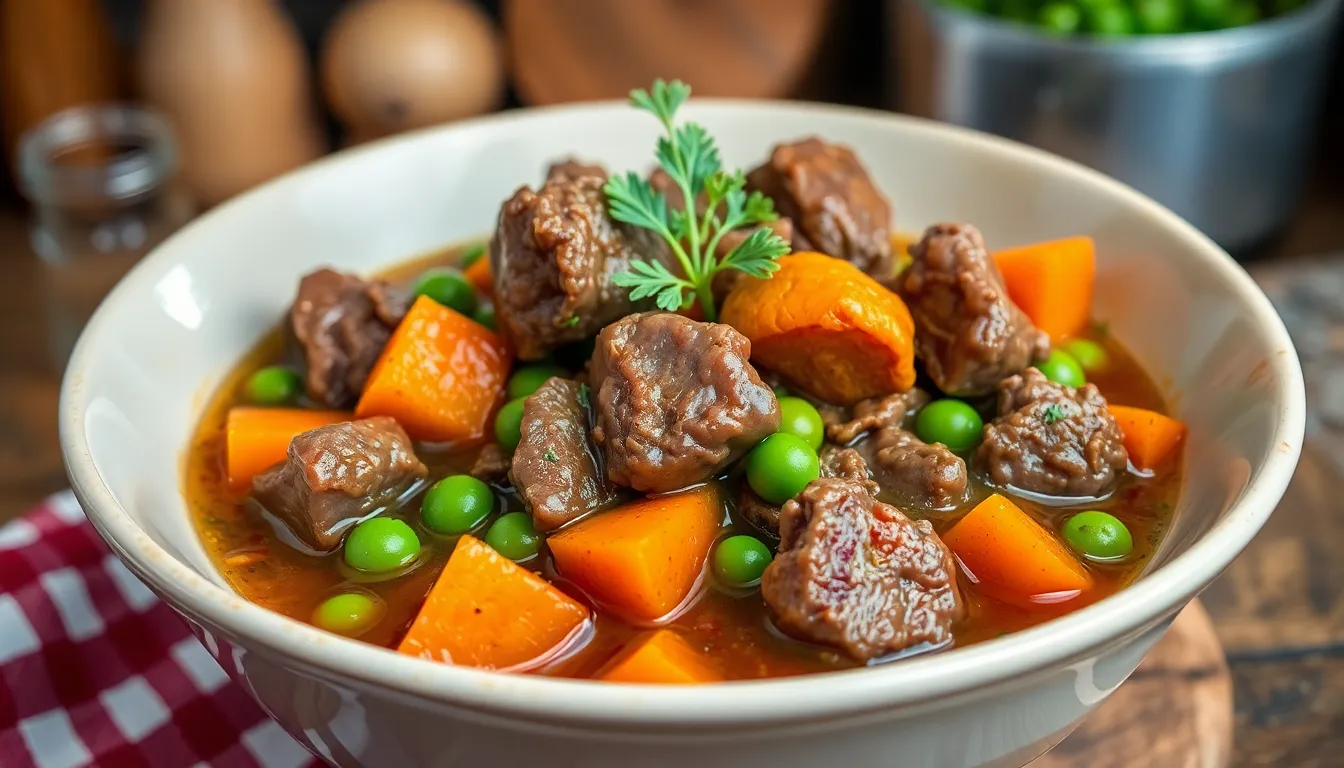
Martha Stewart’s beef stew recipe offers remarkable flexibility while maintaining its signature rich flavor. We can easily adapt this classic recipe to accommodate different dietary needs and taste preferences.
Wine Substitutions
Red wine traditionally enriches our beef stew with deep flavor complexity and helps tenderize the meat during braising. We recommend several excellent alternatives when wine isn’t available or preferred in our cooking.
Additional beef broth combined with a splash of balsamic vinegar maintains the essential acidity and depth that wine typically provides. This substitution delivers comparable flavor enhancement without alcohol content.
Grape juice mixed with a small amount of vinegar creates a wine-like flavor profile that works exceptionally well in our stew. We find this combination particularly effective for families who prefer alcohol-free cooking.
Dry sherry or fortified grape juices serve as excellent alternatives depending on availability and personal taste preferences. These options provide similar flavor depth while offering unique taste variations that complement the beef beautifully.
Vegetable Additions
Our Martha Stewart beef stew traditionally features potatoes and carrots as foundation vegetables that absorb the rich cooking liquid perfectly. We can enhance this base with many additional vegetables for extra flavor and nutrition.
Frozen peas stirred in during the final minutes of cooking add vibrant color and natural sweetness to our finished stew. This simple addition creates visual appeal while providing a pleasant textural contrast.
Onions, celery, and mushrooms can be incorporated early in the cooking process for enhanced complexity and aromatic depth. These vegetables break down during braising and contribute to our stew’s overall richness.
Canned diced tomatoes or tomatoes with green chilies offer tangy brightness and subtle heat variation when added with other vegetables. We particularly enjoy this addition for creating southwestern-inspired flavor profiles.
Fresh cut vegetables work better than frozen varieties for maintaining optimal texture throughout the long cooking process. We recommend cutting all vegetables uniformly to ensure even cooking and professional presentation.
Conclusion
Martha Stewart’s beef stew recipe stands as a testament to the power of quality ingredients and proper technique. We’ve shown you how this beloved comfort food transforms simple components into an extraordinary dining experience through careful preparation and attention to detail.
The beauty of this recipe lies in its adaptability and make-ahead convenience. Whether you’re hosting an intimate dinner party or preparing a weeknight family meal we’re confident this stew will exceed your expectations and become a staple in your recipe collection.
With our comprehensive guide covering everything from ingredient selection to storage tips you’re now equipped to create restaurant-quality beef stew in your own kitchen. The rich flavors and tender textures await – it’s time to start cooking this timeless classic.
Frequently Asked Questions
What makes Martha Stewart’s beef stew recipe so special?
Martha Stewart’s beef stew stands out due to its meticulous attention to flavor layering and cooking techniques. The recipe achieves a perfect balance of tender meat, rich gravy, and well-cooked vegetables through a proven six-stage method that builds complex flavors at each step. Its versatility makes it suitable for both elegant dinner parties and cozy family meals.
What are the key ingredients needed for this beef stew?
The essential ingredients include 2 pounds of beef chuck roast, onions, carrots, celery, tomato paste, red wine, beef stock, potatoes, and mushrooms. An herb bundle featuring thyme, rosemary, and bay leaves adds signature depth. Optional garnishes like fresh parsley, crusty bread, and sour cream enhance the final dish.
What equipment is essential for making this beef stew?
A 5-quart Dutch oven is crucial as it transitions from stovetop to oven seamlessly. You’ll also need a sharp knife and cutting board for uniform prep, measuring cups and spoons for precise ratios, and a mixing spoon. A preheated 350°F oven creates the ideal braising environment for tender results.
How long does it take to prepare and cook the beef stew?
The prep time is approximately 15 minutes when ingredients are organized beforehand. The total cooking process involves browning, building flavor base, simmering, and slow braising in the oven. The six-stage method ensures optimal tenderness and flavor development, yielding six generous servings.
Can I make this beef stew ahead of time?
Yes, the stew actually becomes more flavorful when prepared in advance. Cool completely before refrigerating for up to 3-4 days, or freeze for up to three months. Store in airtight containers and reheat gently on the stovetop. The flavors deepen beautifully overnight, making it perfect for meal planning.
What are the best serving suggestions for this beef stew?
Serve hot in deep bowls to showcase the rich gravy and tender beef. Excellent accompaniments include crusty bread, buttered egg noodles, and fresh parsley garnish. For complete meals, pair with simple green salads or steamed vegetables. Wine pairings like Pinot Noir or Merlot complement the flavors perfectly.
Can I modify the recipe for dietary restrictions?
Absolutely! Use gluten-free flour alternatives for coating the beef. Substitute red wine with additional beef broth mixed with balsamic vinegar or grape juice with vinegar. You can add frozen peas, extra vegetables, or canned tomatoes for variation while maintaining the signature richness and flavor profile.
What’s the secret to achieving perfectly tender beef?
The key is using beef chuck roast cut into uniform 2-inch chunks and coating lightly with flour before browning. This creates a golden crust and helps thicken the stew. The slow braising method in a 350°F oven, combined with proper timing for adding vegetables, ensures both meat and vegetables reach optimal tenderness.

